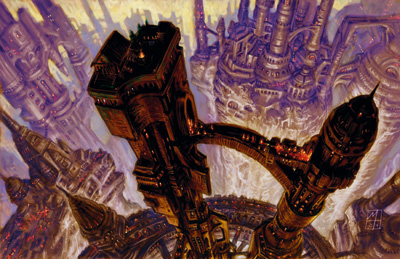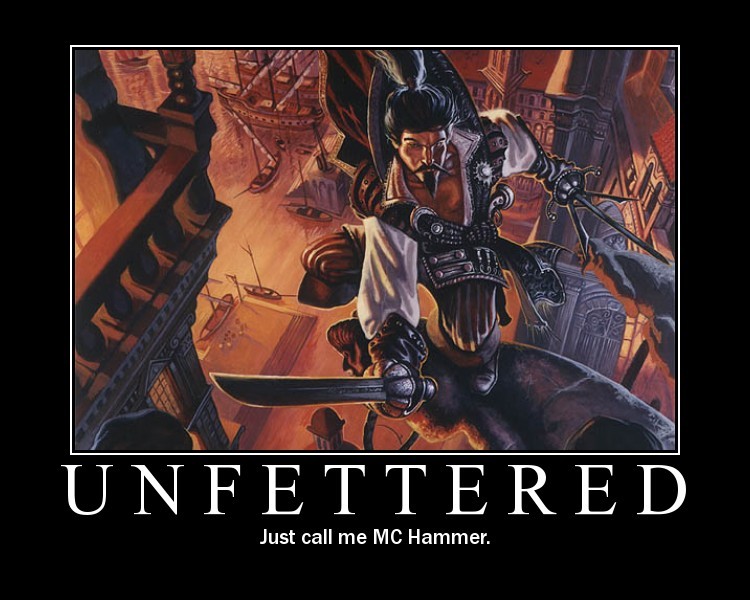 |
| And by class, I mean a hat with horns on it. |
But say you're in a bit of a rush. Well, allow me to present a set of tables for creating a dastardly magic user quickly.
First, he or she needs a name - there are various random generators out there, but none I personally particularly like. I'm sure you can work out something. Maybe name him after a disease? I've always loved "Anthrax" as an evil name.
Now, assuming that your villain is a wizard (a pretty safe assumption), then they'll need spells. I heartily recommend Zak's method of quick spell selection (the battle oracle in the same post is kinda neat too, especially if the PCs consult an oracle before facing the dark lord).
What other dastardly tricks can the dark lord do? One of these, mostly likely. (WARNING, annoying use of bad punctuation and CAPS LOCK. Probably for irony purposes or something).
As an optional third step, what's stopping the PCs from just killing the dark lord? Roll a d20. First 12 results are off this table here, the remainder are below (subtract 12 from result). If you don't like any of these, just do your darndest to make sure they stay out of the PCs' combat reach until a suitably dramatic moment.
- Lich. Hey, it's a classic. Can't be killed unless you find the little box holding his soul.
- Annoyingly complex lich - soul split into several bits, each stored in different objects in different places. Can only die when they've ALL been destroyed.
- Dead man switch - if the bad guy is killed, then something even worse gets to use his dead body as a portal to access the world.
- Soul-bound siblings - somebody the PCs like is actually the twin of this guy, and if one dies, so does the other.
- Minor God - like Thor or Loki from the Avengers, not entirely immortal, but really damned tough. In D&D terms, probably has several times the HP of the entire party put together, and recovers very quickly.
- Baldur-dash - made deals with the spirits/gods of every inanimate material, bar one type of tree (Holly? Oak? Palm-trees?). Can only be hurt by weapons made out of that kind of tree.
- I Think I'm a Clone Now - is actually one of several duplicate copies, all equally skilled. If you kill one, another will arise from the shadows to take over his schemes.
- Was never born in the first place - how he exists in defiance of the laws of causality is a mystery, but he can't actually be killed until targeted with a reincarnate spell.
So... what's the evil plot? Roll a d30, or pick.
Obviously, these are all cribbed from movies, books, or games, and still need some fleshing out. Try not to assuming that the PCs will do anything in particular, just make sure they're in the Villain's path.
- He has kidnapped the princess and transformed her into a swan (or other beast), and will only lift the curse if she agrees to marry him, giving him legitimate claim to the crown.
- Plans to sacrifice a prophetically-picked virgin on the night of the eclipse, after which he will be able to transform into a dragon.
- Has captured the prince and replaced him with a polymorphed lacky. Now living the high-life at the grace of the strangely-acting "prince". Must regularly get blood samples from the prince to maintain the spell.
- Has sent vile minions (orcs are traditional) to retrieve the artifact forged by an even greater and more evil sorcerer in the depths of time. If she gets it, it will greatly magnify his arcane powers.
- Leads army of vile minions (again, probably orcs. Undead are good for this as well, though) on devastating rampage through the kingdom for shits and giggles.
- Seeks to kill the boy whom prophecy says will kill him, so that he can concentrate on world domination scheme without worry.
- His immortality is actually the result of a power possessed by a girl he has had imprisoned for many years. She just escaped, and now he desperately wants her back.
- Trying to get samples/plans of the powers of all the most mighty threats in the world (that alchemist's strength potion, that thief's invisibility enchantment, that inventor's submersible), so he can replicate them for himself.
- As #8 above, but actually just wants the powers to sell to the highest bidder.
- Has been sealed away in a prison deep underground for millenia... and still is. However, has managed to reach out and recruit minions to free him. They've nearly dug through to him, and when they do free him, he's going to be VERY hard to stop.
- Is the subject of an unpleasant curse which prevents him from enjoying food, drink, or the pleasures of intimate company. Breaking the curse requires spilling the blood of the governor's son on a hidden island.
- Already has VAST arcane power, and uses it willy-nilly. Unfortunately, this is more than local reality can stand, and if she keeps it up, the universe is going to fall apart.
- Is releasing a plague to cripple every other magic-user on the planet, so that he will be unopposed.
- Has built a moving fortress that can level whole cities that don't wish to bow to him. Now chasing the princess who managed to get her hands on the designs showing the fortress's one weak spot.
- Loathes new music, and has ruled that only certain specific tunes may be played in her domain. Has awful taste in music.
- Seeks to open a portal to another realm, to allow an extradimensional army access to the world. Once they've pillaged what they want, they will let him rule the remains, or so he believes.
- He has outfitted her army with weapons of frightening power, all in turn powered by a great artifact left behind by the gods, and intends to burn the cities of the world to the ground if not stopped.
- Seeks to eat the heart of a star given human form to renew his youth and power.
- Wants the other two parts of the crown that, when re-formed, will let her command an army of unkillable clockwork golems.
- Has stolen the Book of Peace that protects the great city from constant terrible weather and bad luck. Probably, again, for shits and giggles.
- Is having a mighty monument built in his honor, out of pure vanity, using slave labor.
- Seeks the key to unlock the gate that will allow his overly-tentacled patron access to the world. Actually summoned the key many years ago, but lost track of it since.
- When the stars align, will unleash titans to battle and defeat the gods so that she can take their place. The mortal world probably won't survive being a godly battlefield.
- Trying to hunt down the Orb of Ultimate Knowledge, a device allowing access to every bit of information that will ever be known to mortal kind, if the user has the willpower to command it. She kidnaps the descendants of those who hid the orb, intending to use ancestral memories to find it.
- Is propagating monsters of a particular type (some kind of contagious undead?) so that when they're killed by the heroes, she can collect the energy they release when they are destroyed. With enough energy, will be able to get her soul back. Doesn't really care how many people die along the way.
- Previously a member of an order of monster-hunters, she got sick of the order making compromises, and decided to join the monsters, leading them to hunt down the order, and anybody else nearby.
- He leads a cult of fanatically loyal followers on a mission to activate a series of ancient weapon emplacements. While he's told them that activating the weapons will pave the way to heaven, he hasn't told them that it will do so by killing everything on the planet.
- She is ruler of an area due to monopoly on something that the local populace needs - food, water, air. But now somebody knows where the thing that will break that monopoly is hidden, and she's going to try to capture them before they can reveal all.
- He is trying to capture the oracle who can lead him to the rune-bound iron cauldron that can raise an army of unstoppable undead.
- She seeks the sacrificial victims and ancient tome required to resurrect her dead lover. Plans on doing a little romantic civilization-toppling when she has him back.
Visual details - roll two or three times. For conflicting results either re-roll, or work out some way that the Dark Lord is BOTH, such as having a combat form, or concealing her appearance with illusions.
- Bald
- Intricately styled hair
- Has only one eye
- Rubbish beard
- Young and handsome looking
- Terrible teeth
- Very fat
- Quite old, but still handsome-looking
- No nose
- Peculiar skin tone - pasty white, ashen grey, etc.
- Large nose
- Horned helmet
- Black armour
- Very tall and well muscled
- Gaunt
- Impeccably well-dressed
- Significant portions of body replaced with golem components (clockwork? Stone? wood?).
- Actually exudes smoke or fire.
- Really severe makeup.
- Tall, even by evil villain standards.
There you have it, some terribly haphazard tables for making bad guys. I realize they're unlikely to be overly useful to anybody, but writing them was fun and interesting.





